Search
- Page Path
-
- HOME
- Search
- Review Article
- Cardiology
- Application of CRISPR-Cas9 gene editing for congenital heart disease
- Heeyoung Seok, Rui Deng, Douglas B. Cowan, Da-Zhi Wang
- Clin Exp Pediatr. 2021;64(6):269-279. Published online March 2, 2021
-

Clustered regularly interspaced short palindromic repeats and CRISPR-associated protein 9 (CRISPR-Cas9) system has made a big step in the genome editing which still requires technical developments for the efficient applications in the many fields including congenital heart diseases (CHDs), closely related to the genomic abnormality. In this review, we tried to cover the most updated researches of CRISPR-Cas9 in the CHDs to understand the current technologies, eventually becoming therapeutic bases for the CHD patients.
- Infection
- Consideration in treatment decisions for refractory Mycoplasma pneumoniae pneumonia
- Hye-Kyung Cho
- Clin Exp Pediatr. 2021;64(9):459-467. Published online February 10, 2021
-

• To avoid unnecessary exposure to secondary antibiotics, it is needed to diagnose Mycoplasma pneumoniae (MP) pneumonia carefully, especially when unresponsiveness to macrolide is suspected.
• Serologic and molecular tests for MP infection and excluding respiratory infection caused by other pathogens might be considered.
• It is necessary to continuously monitor antibiotic susceptibility of MP, and efforts to lower antibiotic pressure are required.
- Allergy
- Eosinophils and childhood asthma
- Bong Seok Choi
- Clin Exp Pediatr. 2021;64(2):60-67. Published online January 6, 2021
-
•In allergic eosinophilic asthma, eosinophils act as important effector cells and antigen-presenting cells, while in nonallergic eosinophilic asthma, type 2 innate lymphoid cells play an important role in eosinophil activation.
•Sputum eosinophil counts can be helpful for evaluating allergic airway inflammation in asthma.
• Anti-interleukin-5 has broadened the scope of asthma treatment.
- Original Article
- Allergy
- Cohort profile: National Investigation of Birth Cohort in Korea study 2008 (NICKs-2008)
- Ju Hee Kim, Jung Eun Lee, So Min Shim, Eun Kyo Ha, Dong Keon Yon, Ok Hyang Kim, Ji Hyeon Baek, Hyun Yong Koh, Kyu Young Chae, Seung Won Lee, Man Yong Han
- Clin Exp Pediatr. 2021;64(9):480-488. Published online January 5, 2021
-

This national cohort study included all Korean children born in 2008 and 2009 observed over a period of more than 10 years. Our findings demonstrate that it is possible to analyze disease onset prior to hospitalization based on information such as lifestyle, eating habits, and risk factors by integrating National Health Insurance System data with national health screening data.
- Review Article
- General Pediatrics
- Clinical features, diagnosis, and outcomes of multisystem inflammatory syndrome in children associated with coronavirus disease 2019
- Ji Hee Kwak, Soo-Young Lee, Jong-Woon Choi; the Korean Society of Kawasaki Disease
- Clin Exp Pediatr. 2021;64(2):68-75. Published online December 30, 2020
-

Hundreds of cases of children and adolescents with hyperinflammatory responses such as Kawasaki disease have been reported amid the coronavirus disease 2019 (COVID-19) pandemic, leading to coining of the new term COVID-19–associated multisystem inflammatory syndrome in children. In this review article, we introduce the illness and describe its case definitions, epidemiology, pathogenesis, clinical features, treatments, and outcomes.
- Nutrition
- Dietary intake and nutritional status of Korean children and adolescents: a review of national survey data
- Minji Kang, So Yoon Choi, Minyoung Jung
- Clin Exp Pediatr. 2021;64(9):443-458. Published online December 28, 2020
-

In Korea, several national cross-sectional surveys monitor the diet, nutritional status, and health status of children. This continual dedicated national surveillance system contributes to the identification of nutritional and health issues, establishment of public health policies, and development of nutrition recommendations. This paper provides recent information about the Korea National Health and Nutrition Examination Survey and the Korean Youth Risk...
- Critical Care Medicine
- Pediatric postintensive care syndrome: high burden and a gap in evaluation tools for limited-resource settings
- Chanapai Chaiyakulsil, Rapee Opasatian, Paweethida Tippayawong
- Clin Exp Pediatr. 2021;64(9):436-442. Published online December 18, 2020
-
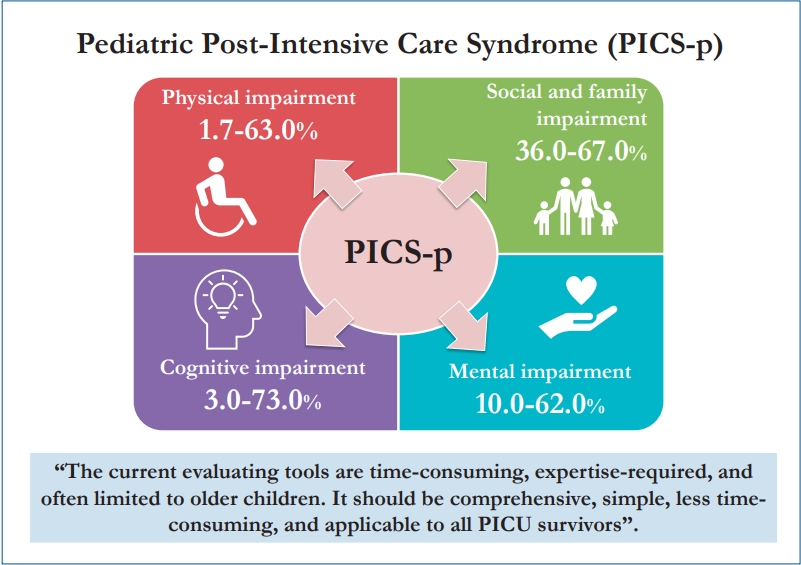
Pediatric postintensive care syndrome has high impact and burden and can affect a child’s life for decades. The early evaluation and detection of such problems require a simple and less time-consuming surveillance tool. Current evaluation tools can be difficult and strenuous for areas with limited resources. Thus, a new simple tool is required for the early detection and intervention of postintensive care syndrome in critically ill children
- Guideline
- Endocrinology
- 2017 Clinical practice guidelines for dyslipidemia of Korean children and adolescents
- Jung Sub Lim, Eun Young Kim, Jae Hyun Kim, Jae-Ho Yoo, Kyung Hee Yi, Hyun Wook Chae, Jin-Ho Choi, Ji Young Kim, Il Tae Hwang; the Committee of Dyslipidemia of Korean Children and Adolescents on behalf of Korean Society of Pediatric Endocrinology (KSPE)
- Clin Exp Pediatr. 2020;63(12):454-462. Published online November 25, 2020
-

Question: How are children and adolescents with dyslipidemia treated and managed in Korea?
Finding: 2017 guidelines recommend to measure nonfasting non-HDL-C as a screening test and introduce new diet methods: Cardiovascular Health Integrated Lifestyle Diet (CHILD)-1, CHILD-2-low-density lipoprotein cholesterol, and CHILD-2-triglyceride. Statin is the only drug approved in children older than 10 years.
Meaning: New clinical practice guidelines for treating and managing dyslipidemia of Korean children and adolescents are provided.
- Original Article
- Infection
- Prevalence of methicillin-resistant Staphylococcus aureus in Iranian children: a systematic review and meta-analysis
- Farhad Sarrafzadeh, Seyed Mojtaba Sohrevardi, Hamid Abousaidi, Hossein Mirzaei
- Clin Exp Pediatr. 2021;64(8):415-421. Published online November 20, 2020
-
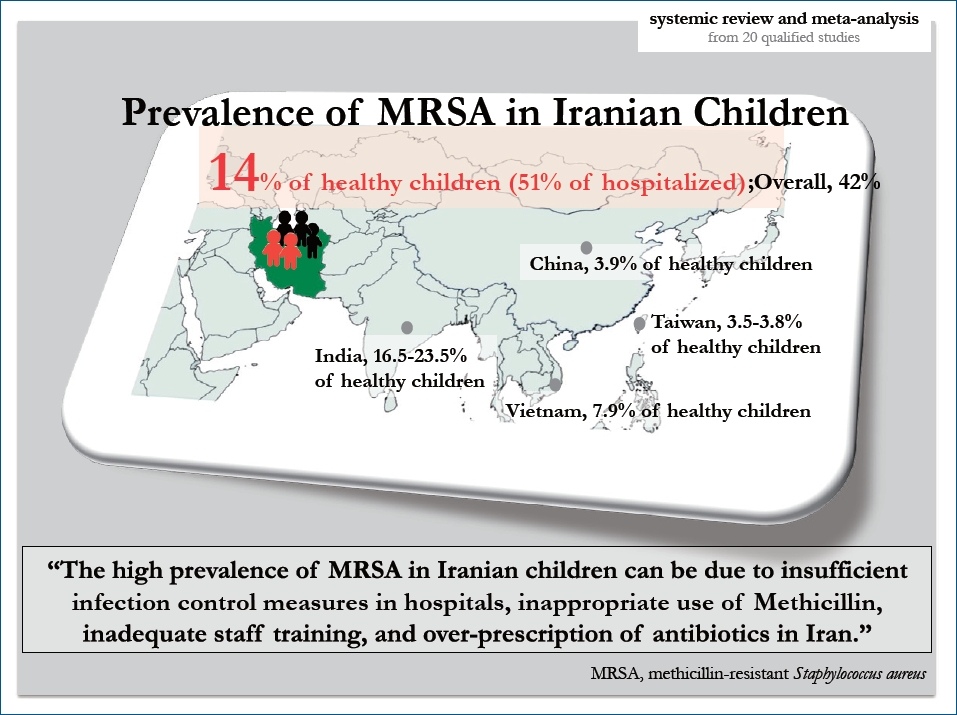
The pooled prevalence of methicillin-resistant Staphylococcus aureus (MRSA) was 42% among culture-positive cases of S. aureus, 51% in hospitalized children, and 14% in healthy children. The high prevalence of MRSA in Iranian children may be due to insufficient infection control measures in hospitals, inappropriate use of methicillin, inadequate staff training, and over-prescription of antibiotics in Iran.
- Review Article
- Infection
- The COVID-19 pandemic: an unprecedented tragedy in the battle against childhood obesity
- Maximilian Andreas Storz
- Clin Exp Pediatr. 2020;63(12):477-482. Published online November 5, 2020
-
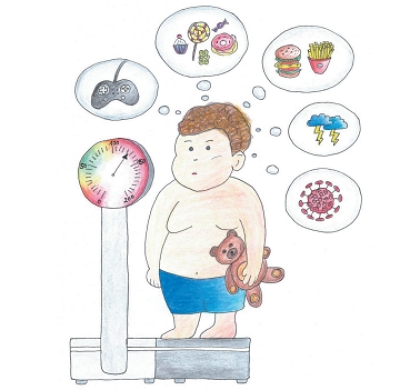
Large-scale quarantine and home confinement during the coronavirus disease 2019 (COVID-19) pandemic will impose new and unfamiliar stressors on children, thereby worsening the childhood obesity epidemic. Physical, nutritional, and psychosocial factors that promote obesity in children during this special situation complementarily contribute to an unprecedented obesogenic environment. Involved stakeholders, including governments, schools, and families, must make all efforts to minimize the impact of the COVID-19 epidemic on childhood obesity.
- Original Article - Clinical trial
- WITHDRAWN:Randomized controlled trial of effect of N-acetylcysteine as an antioxidant on iron overload in children with thalassemia major
- Yasmen A Mohamed, Mohamed H Meabed, Amany Ashraf, Dalia S Morgan, Mostafa G Abdul Latif, Rehab M Abd-Elkareem, Heba M Ahmed
-
Background: β-Thalassemias are characterized by the presence of mutations in the globin gene that result in the absence or reduced synthesis of β-globin chains of the hemoglobin tetramer. Several studies have reported increased oxidative stress in β-thalassemia major (β-TM) patients. N-acetylcysteine (NAC), a derivative of L-cysteine amino acid, is commonly used as a mucolytic drug. Numerous studies have reported efficient... -
- Original Article
- Allergy
- Influence of age at complementary food introduction on the development of asthma and atopic dermatitis in Korean children aged 1–3 years
- Jihyun Lee, Meeyong Shin, Bora Lee
- Clin Exp Pediatr. 2021;64(8):408-414. Published online November 1, 2020
-

Question: Is age at the time of complementary food introduction associated with asthma and atopic dermatitis (AD) in early childhood?
Finding: We found no significant association between age at the time of complementary food introduction and the incidence of AD and asthma in Koreans aged 1–3 years.
Meaning: Our findings suggest that the influence of individual allergenic foods on the development of AD and asthma should be clarified.
- Nephrology (Genitourinary)
- Expression profiling of cultured podocytes exposed to nephrotic plasma reveals intrinsic molecular signatures of nephrotic syndrome
- Stuti Panigrahi, Varsha Chhotusing Pardeshi, Karthikeyan Chandrasekaran, Karthik Neelakandan, Hari PS, Anil Vasudevan
- Clin Exp Pediatr. 2021;64(7):355-363. Published online November 1, 2020
-

Question: Is it possible to classify nephrotic syndrome (NS) through gene expression profiling of podocytes exposed to NS plasma?
Finding: Our data showed different expression profiles in podocytes exposed to nephrotic plasma from different clinical groups, suggesting the molecular stratification of patients into intrinsic subtypes.
Meaning: Transcriptome profiling of podocytes treated with NS plasma can stratify patients into intrinsic subtypes and provide insight into the molecular mechanisms of podocyte injury.
- Gastroenterology
- Celiac disease in children: Increasing prevalence and changing clinical presentations
- Hasan M. Isa, Eman Farid, Jaafar J. Makhlooq, Afaf M. Mohamed, Jumana G. Al-Arayedh, Fawzeya A. Alahmed, Shima Medani
- Clin Exp Pediatr. 2021;64(6):301-309. Published online October 17, 2020
-
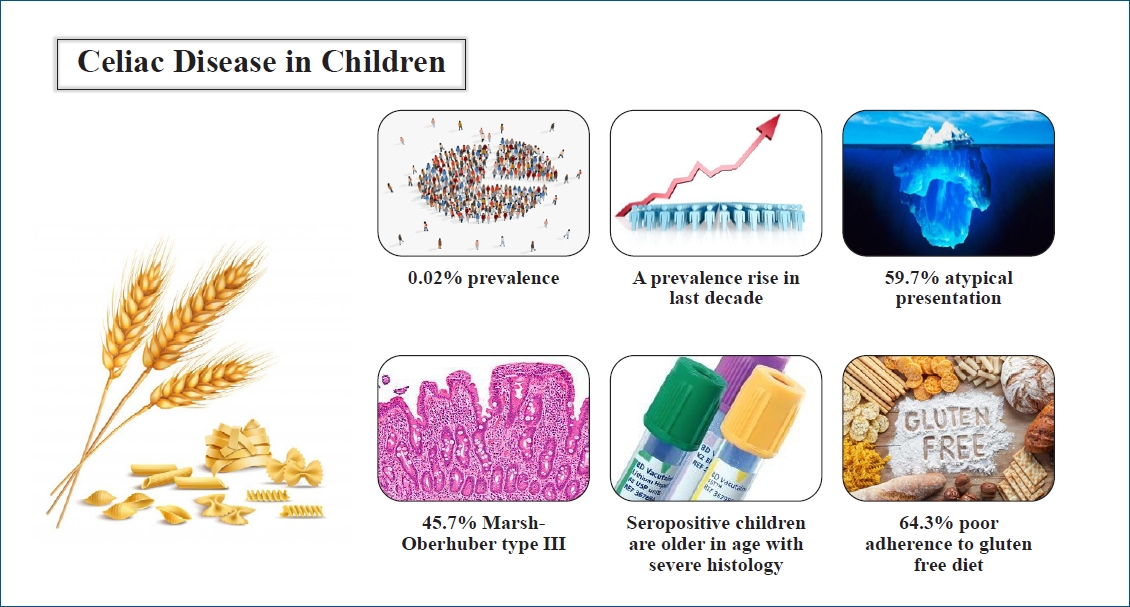
Question: What are the prevalence and clinical characteristics of celiac disease (CD) in children in Bahrain?
Finding: We found a significant increase in CD prevalence over the last decade (P=0.0001). A male predominance was noted. Atypical presentations were common. Most patients had poor adherence to a gluten-free diet.
Meaning: CD is an underdiagnosed condition. Atypical symptoms should be considered to prevent missing patients with CD.
- Endocrinology
- Zinc transporter 8 autoantibody in the diagnosis of type 1 diabetes in children
- Nur Rochmah, Muhammad Faizi, Siti Wahyu Windarti
- Clin Exp Pediatr. 2020;63(10):402-405. Published online October 6, 2020
-

Question: Can zinc transporter 8 autoantibody (ZnT8A) be used for diagnosing type 1 diabetes (T1D)?
Finding: Twenty-two of 30 subjects with type 1 diabetes (73.3 %) were positive for ZnT8A compared to 5 of 18 controls (27.8%).
Meaning: ZnT8A has potential for clinical applications in the diagnosis of T1D.
- Review Article
- Gastroenterology
- Causes of acute gastroenteritis in Korean children between 2004 and 2019
- Eell Ryoo
- Clin Exp Pediatr. 2021;64(6):260-268. Published online September 18, 2020
-

· Norovirus is the most common virus in Korean children with acute gastroenteritis.
· Escherichia coli and Salmonella spp. are the most common cause of bacterial gastroenteritis in Korean children, with a detection rate of 3%–20%.
· Uncommon bacterial and parasitic gastroenteritis require attention because of increasing international exchange and overseas travel.
- Original Article
- Gastroenterology
- Value of the International Classification of Diseases code for identifying children with biliary atresia
- Pornthep Tanpowpong, Chatmanee Lertudomphonwanit, Pornpimon Phuapradit, Suporn Treepongkaruna
- Clin Exp Pediatr. 2021;64(2):80-85. Published online August 24, 2020
-

Question: What is the value of the diagnostic code in identifying cases of biliary atresia in a large administrative database?
Finding: The diagnostic code’s accuracy and sensitivity are acceptable for identifying algorithm-defined cases. A history of pale stool and a presumed diagnosis of biliary atresia prior to referral added value.
Meaning: The addition of clinical data to the diagnostic code significantly increased the diagnostic yield.
- Review Article
- Critical Care Medicine
- The use of extracorporeal membrane oxygenation in children with acute fulminant myocarditis
- Silver Heinsar, Sainath Raman, Jacky Y. Suen, Hwa Jin Cho, John F. Fraser
- Clin Exp Pediatr. 2021;64(5):188-195. Published online August 10, 2020
-

Acute fulminant myocarditis (AFM) occurs as an inflammatory response to an initial myocardial insult. Its rapid and deadly progression calls for prompt diagnosis with aggressive treatment measures. The demonstration of its excellent recovery potential has led to increasing use of mechanical circulatory support, especially extracorporeal membrane oxygenation (ECMO). Arrhythmias, organ failure, elevated cardiac biomarkers, and decreased ventricular function at presentation...
- Original Article
- Gastroenterology
- Evaluating the effects of probiotics in pediatrics with recurrent abdominal pain
- Parisa Rahmani, Azin Ghouran-orimi, Farzaneh Motamed, Alireza Moradzadeh
- Clin Exp Pediatr. 2020;63(12):485-490. Published online July 21, 2020
-
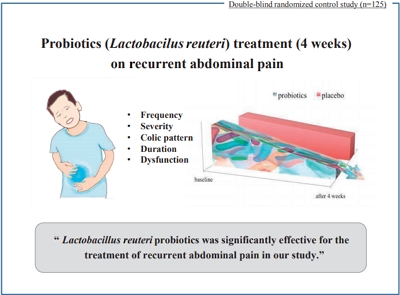
Question: ecurrent abdominal pain (RAP) is a chief complaint among pediatrics and is associated with reduced quality of life, for both parent and child, and economic burden. Does probiotics reduce the frequency of RAP among children?
Finding: This study reported the effects of Lactobacillus reuteri probiotics among children with RAP as a result of multiple etiologies.
Meaning: The administration of probiotic supplements is significantly associated with pain relief among RAP children presented with functional abdominal pain, irritable bowel syndrome, and functional dyspepsia.
- Review Article
- Pulmonology
- Overview of management of children with COVID-19
- Dyah Kanya Wati, Arya Krisna Manggala
- Clin Exp Pediatr. 2020;63(9):345-354. Published online July 17, 2020
-

The specific treatments for COVID-19 in children remain inconclusive and debatable despite effectively decreasing its signs and symptoms.
The need for clinical trials and reports should be investigated.
- Gastroenterology
- Changing prevalence of Helicobacter pylori infection in children and adolescents
- Ji Sook Park, Jin Su Jun, Ji-Hyun Seo, Hee-Shang Youn, Kwang-Ho Rhee
- Clin Exp Pediatr. 2021;64(1):21-25. Published online July 15, 2020
-
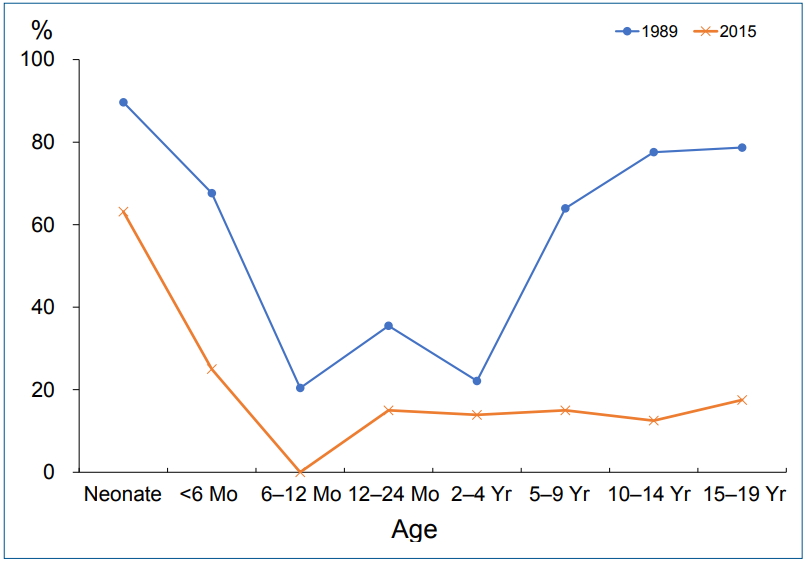
Although Helicobacter pylori infection rate in children is unclear due to diversity and limitation of diagnostic tests unlike in adults, investigation the childhood prevalence is important for predicting H. pylori-related diseases in the future.
H. pylori infection occurred in early childhood, and declined during 30 years in our study.
Change in risk factors of H. pylori transmission and consensus for eradication therapy in children might further reduce the infection rate.
- Original Article
- Nephrology (Genitourinary)
- Sonographic renal length and volume of normal Thai children versus their Chinese and Western counterparts
- Chantima Rongviriyapanich, Thanarat Sakunchit, Chirawat Sudla, Supamas Mungkung, Napapong Pongnapang, Chai Hong Yeong
- Clin Exp Pediatr. 2020;63(12):491-498. Published online July 13, 2020
-

Question: What is the normal renal size of Thai children and is the renal nomogram comparable to those of Western and Chinese cohorts?
Finding: The renal length of Thai children was moderately correlated with that of Western children, while the age-specific renal volume was significantly smaller than that of Chinese children.
Meaning: Renal size in children can vary among regions and sociodemographic backgrounds; hence, a local reference standard is needed.
- Review Article
- Other
- Review of epidemiological studies on air pollution and health effects in children
- Jong-Tae Lee
- Clin Exp Pediatr. 2021;64(1):3-11. Published online June 10, 2020
-

This review summarized the accumulated epidemiologic evidence with emphasis on studies conducted in Korea and heterogeneity in the literature. Based on systematic reviews and meta-analyses, there is consistent evidence on the association between exposure to ambient air pollution and children’s health, especially respiratory health and adverse birth outcomes, and growing evidence on neurodevelopmental outcomes.
- Pulmonology
- Current perspectives on atypical pneumonia in children
- Jung Yeon Shim
- Clin Exp Pediatr. 2020;63(12):469-476. Published online June 10, 2020
-

Macrolides are the first line treatment in atypical pneumonia caused by M. pneumoniae, C. pneumoniae, and L. pneumophila. Macrolide-resistant mycoplasma pneumonia (MRMP) is emerging worldwide, especially in East Asia. Immune modulators such as corticosteroids or second line antibiotics are treatment options for MRMP. Pediatricians should be careful with empirical therapy of macrolides in children with mild to moderate community-acquired pneumonia not to increase the risk of MRMP.
- Neurology
- Health effects of electromagnetic fields on children
- Jin-Hwa Moon
- Clin Exp Pediatr. 2020;63(11):422-428. Published online May 26, 2020
-
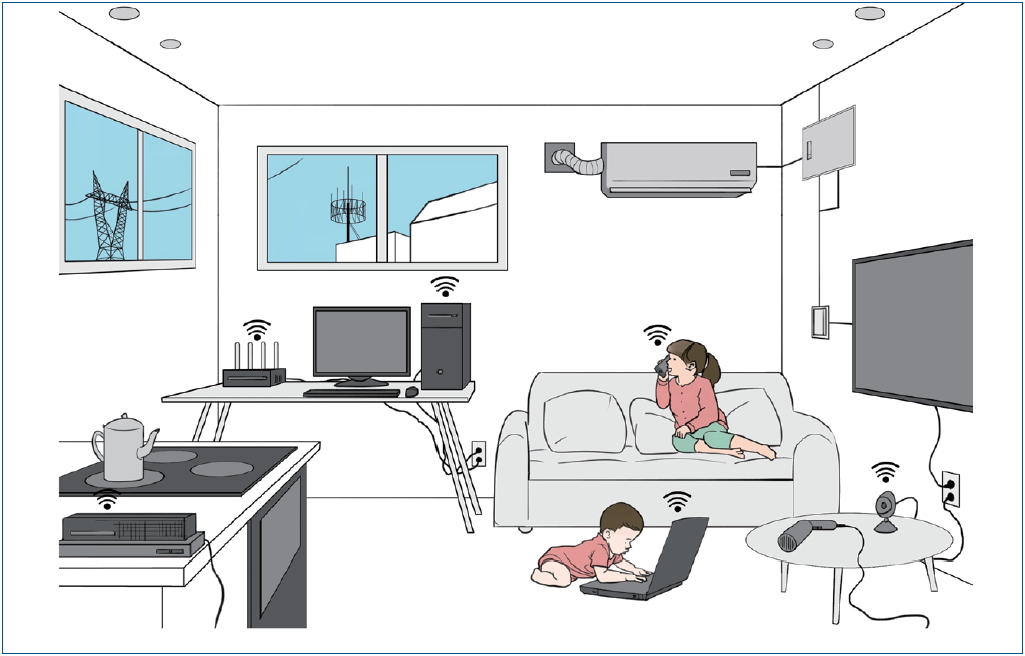
· The nervous systems of children are more vulnerable to the effects of electromagnetic waves than adults.
· The exposure to electromagnetic fields (EMFs) among children should be minimized.
· According to International Agency for Research on Cancer EMFs are possibly carcinogenic, it should not be overlooked or interpreted with bias.
- Original Article
- General Pediatrics
- Efficacy of conservative treatment of perianal abscesses in children and predictors for therapeutic failure
- Lars Boenicke, Johannes Doerner, Stefan Wirth, Hubert Zirngibl, Mike Ralf Langenbach
- Clin Exp Pediatr. 2020;63(7):272-277. Published online May 15, 2020
-

Background: The optimal management of perianal abscess in children is controversial.
Purpose: To evaluate the efficiency of conservative treatment of perianal abscess in children and identify parameters that predict therapy failure. Methods: All cases of children younger than 14 years of age with perianal abscesses between 2001–2016 were evaluated. Results: Of the 113 enrolled patients, 64 underwent subsequent surgery for advanced disease (primary...
- Review Article
- Allergy
- Pollen-food allergy syndrome in children
- You Hoon Jeon
- Clin Exp Pediatr. 2020;63(12):463-468. Published online May 14, 2020
-

The prevalence of pollen-food allergy syndrome (PFAS) in Korean children with pollen allergy was recently reported to be 42.7%. PFAS can cause a wide range of symptoms from mild allergy to severe anaphylaxis depending on the nature of food allergens that share the epitopes with pollen. Cases of anaphylaxis caused by PFAS have recently increased. Treatments for PFAS should be individualized for patients according to the severity of symptoms.
- Original Article
- Developmental and Behavioral Medicine
- Development of the Korean Developmental Screening Test for Infants and Children (K-DST)
- Hee Jung Chung, Donghwa Yang, Gun-Ha Kim, Sung Koo Kim, Seoung Woo Kim, Young Key Kim, Young Ah Kim, Joon Sik Kim, Jin Kyung Kim, Cheongtag Kim, In-Kyung Sung, Son Moon Shin, Kyung Ja Oh, Hee-Jeong Yoo, Hee Joon Yu, Seoung-Joon Lim, Jeehun Lee, Hae-Ik Jeong, Jieun Choi, Jeong-Yi Kwon, Baik-Lin Eun
- Clin Exp Pediatr. 2020;63(11):438-446. Published online May 14, 2020
-
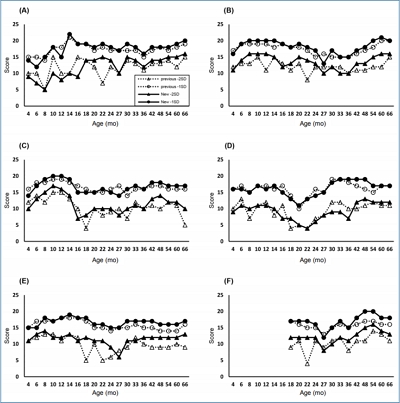
Question: Can the Korean Developmental Screening Test for Infants and Children (K-DST) be a useful screening tool for infants and children in Korea?
Finding: The K-DST has high reliability (internal consistency of 0.73–0.93, test-retest reliability of 0.77–0.88) and a high discriminatory ability with a sensitivity of 0.833 and specificity of 0.979.
Meaning: The K-DST is an effective and reliable screening tool for infants and children with neurodevelopmental disorders in Korea.
- Review Article
- Infection
- Epidemiology and clinical features of coronavirus disease 2019 in children
- Soo-Han Choi, Han Wool Kim, Ji-Man Kang, Dong Hyun Kim, Eun Young Cho
- Clin Exp Pediatr. 2020;63(4):125-132. Published online April 6, 2020
-

Coronavirus disease-2019 (COVID-19), which started in Wuhan, China, in December 2019 and declared a worldwide pandemic on March 11, 2020, is a novel infectious disease that causes respiratory illness and death. Pediatric COVID-19 accounts for a small percentage of patients and is often milder than that in adults; however, it can progress to severe disease in some cases. Even neonates...
- Original Article
- Endocrinology
- Influence of subclinical hypothyroidism on metabolic parameters in obese children and adolescents
- Ozlem Kara
- Clin Exp Pediatr. 2020;63(3):110-114. Published online March 6, 2020
-

Question: Does subclinical hypothyroidism in obese children and adolescents affect metabolic parameters?
Finding: Insulin, HOMA-IR, and TG levels were higher and the HDL-C level was lower in patients with SH.
Meaning: A clear association is observed between SH, and insulin resistance and dyslipidemia in obese children. It can be said that the TSH may be evaluated as a metabolic risk factor in obese patients.
-

-
-
6.02024CiteScore98th percentilePowered by
-
Impact Factor3.6
-
- TOPICS
- ARTICLE CATEGORY
- Editorial Office
-
Korean Pediatric Society
#1606 Seocho World Officetel, 19 Seoun-ro, Seocho-ku, Seoul 06732, Korea
Tel: +82-2-3473-7306 Fax: +82-2-3473-7307 E-mail: office@e-cep.org
Clinical and Experimental Pediatrics is an open access journal. All articles are distributed under the terms of the Creative Commons Attribution NonCommercial License (http://creativecommons.org/licenses/by-nc/4.0/)
Copyright © 2025 by Korean Pediatric Society.











